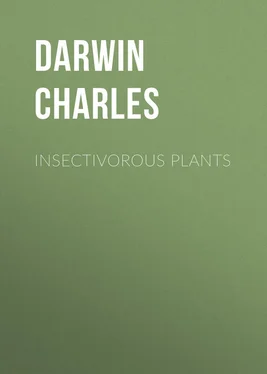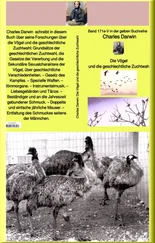Charles Darwin - Insectivorous Plants
Здесь есть возможность читать онлайн «Charles Darwin - Insectivorous Plants» — ознакомительный отрывок электронной книги совершенно бесплатно, а после прочтения отрывка купить полную версию. В некоторых случаях можно слушать аудио, скачать через торрент в формате fb2 и присутствует краткое содержание. Жанр: foreign_antique, foreign_prose, на английском языке. Описание произведения, (предисловие) а так же отзывы посетителей доступны на портале библиотеки ЛибКат.
- Название:Insectivorous Plants
- Автор:
- Жанр:
- Год:неизвестен
- ISBN:нет данных
- Рейтинг книги:5 / 5. Голосов: 1
-
Избранное:Добавить в избранное
- Отзывы:
-
Ваша оценка:
- 100
- 1
- 2
- 3
- 4
- 5
Insectivorous Plants: краткое содержание, описание и аннотация
Предлагаем к чтению аннотацию, описание, краткое содержание или предисловие (зависит от того, что написал сам автор книги «Insectivorous Plants»). Если вы не нашли необходимую информацию о книге — напишите в комментариях, мы постараемся отыскать её.
Insectivorous Plants — читать онлайн ознакомительный отрывок
Ниже представлен текст книги, разбитый по страницам. Система сохранения места последней прочитанной страницы, позволяет с удобством читать онлайн бесплатно книгу «Insectivorous Plants», без необходимости каждый раз заново искать на чём Вы остановились. Поставьте закладку, и сможете в любой момент перейти на страницу, на которой закончили чтение.
Интервал:
Закладка:
If a leaf is immersed in a very strong, almost concentrated, solution of carbonate of ammonia, the glands are instantly blackened, and they secrete copiously; but no movement of the tentacles ensues. Two leaves thus treated became after 1 hr. flaccid, and seemed killed; all the cells in their tentacles contained spheres of protoplasm, but these were small and discoloured. Two other leaves were placed in a solution not quite so strong, and there was well-marked aggregation in 30 m. After 24 hrs. the spherical or more commonly oblong masses of protoplasm became opaque and granular, instead of being as usual translucent; and in the lower cells there were only innumerable minute spherical granules. It was evident that the strength of the solution had interfered with the completion of the process, as we shall see likewise follows from too great heat.
All the foregoing observations relate to the exterior tentacles, which are of a purple colour; but the green pedicels of the short central tentacles are acted on by the carbonate, and by an infusion of raw meat, in exactly the same manner, with the sole difference that the aggregated masses are of a greenish colour; so that the process is in no way dependent on the colour of the fluid within the cells.
Finally, the most remarkable fact with respect to this salt is the extraordinary small amount which suffices to cause aggregation. Full details will be given in the seventh chapter, and here it will be enough to say that with a sensitive leaf the absorption by a gland of 1/134400 of a grain (.000482 mgr.) is enough to cause in the course of one hour well-marked aggregation in the cells immediately beneath the gland.
The Effects of certain other Salts and Fluids. – Two leaves were placed in a solution of one part of acetate of ammonia to about 146 of water, and were acted on quite as energetically, but perhaps not quite so quickly, as by the carbonate. After 10 m. the glands were black, and in the cells beneath them there were traces of aggregation, which after 15 m. was well marked, extending down the tentacles for a length equal to that of the glands. After 2 hrs. the contents of almost all the cells in all the tentacles were broken up into masses of protoplasm. A leaf was immersed in a solution of one part of oxalate of ammonia to 146 of water; and after 24 m. some, but not a conspicuous, change could be seen within the cells beneath the glands. After 47 m. plenty of spherical masses of protoplasm were formed, and these extended down the tentacles for about the length of the glands. This salt, therefore, does not act so quickly as the carbonate. With respect to the citrate of ammonia, a leaf was placed in a little solution of the above strength, and there was not even a trace of aggregation in the cells beneath the glands, until 56 m. had elapsed; but it was well marked after 2 hrs. 20 m. On another occasion a leaf was placed in a stronger solution, of one part of the citrate to 109 of water (4 grs. to 1 oz.), and at the same time another leaf in a solution of the carbonate of the same strength. The glands of the latter were blackened in less than 2 m., and after 1 hr. 45 m. the aggregated masses, which were spherical and very dark-coloured, extended down all the tentacles, for between half and two-thirds of their lengths; whereas in the leaf immersed in the citrate the glands, after 30 m., were of a dark red, and the aggregated masses in the cells beneath them pink and elongated. After 1 hr. 45 m. these masses extended down for only about one-fifth or one-fourth of the length of the tentacles.
Two leaves were placed, each in ten minims of a solution of one part of nitrate of ammonia to 5250 of water (1 gr. to 12 oz.), so that each leaf received 1/576 of a grain (.1124 mgr.). This quantity caused all the tentacles to be inflected, but after 24 hrs. there was only a trace of aggregation. One of these same leaves was then placed in a weak solution of the carbonate, and after 1 hr. 45 m. the tentacles for half their lengths showed an astonishing degree of aggregation. Two other leaves were then placed in a much stronger solution of one part of the nitrate to 146 of water (3 grs. to 1 oz.); in one of these there was no marked change after 3 hrs.; but in the other there was a trace of aggregation after 52 m., and this was plainly marked after 1 hr. 22 m., but even after 2 hrs. 12 m. there was certainly not more aggregation than would have fol- lowed from an immersion of from 5 m. to 10 m. in an equally strong solution of the carbonate.
Lastly, a leaf was placed in thirty minims of a solution of one part of phosphate of ammonia to 43,750 of water (1 gr. to 100 oz.), so that it received 1/1600 of a grain (.04079 mgr.); this soon caused the tentacles to be strongly inflected; and after 24 hrs. the contents of the cells were aggregated into oval and irregularly globular masses, with a conspicuous current of protoplasm flowing round the walls. But after so long an interval aggregation would have ensued, whatever had caused inflection.
Only a few other salts, besides those of ammonia, were tried in relation to the process of aggregation. A leaf was placed in a solution of one part of chloride of sodium to 218 of water, and after 1 hr. the contents of the cells were aggregated into small, irregularly globular, brownish masses; these after 2 hrs. were almost disintegrated and pulpy. It was evident that the protoplasm had been injuriously affected; and soon afterwards some of the cells appeared quite empty. These effects differ altogether from those produced by the several salts of ammonia, as well as by various organic fluids, and by inorganic particles placed on the glands. A solution of the same strength of carbonate of soda and carbonate of potash acted in nearly the same manner as the chloride; and here again, after 2 hrs. 30 m., the outer cells of some of the glands had emptied themselves of their brown pulpy contents. We shall see in the eighth chapter that solutions of several salts of soda of half the above strength cause inflection, but do not injure the leaves. Weak solutions of sulphate of quinine, of nicotine, camphor, poison of the cobra, &c., soon induce well-marked aggregation; whereas certain other substances (for instance, a solution of curare) have no such tendency.
Many acids, though much diluted, are poisonous; and though, as will be shown in the eighth chapter, they cause the tentacles to bend, they do not excite true aggregation. Thus leaves were placed in a solution of one part of benzoic acid to 437 of water; and in 15 m. the purple fluid within the cells had shrunk a little from the walls, yet when carefully examined after 1 hr. 20 m., there was no true aggregation; and after 24 hrs. the leaf was evidently dead. Other leaves in iodic acid, diluted to the same degree, showed after 2 hrs. 15 m. the same shrunken appearance of the purple fluid within the cells; and these, after 6 hrs. 15 m., were seen under a high power to be filled with excessively minute spheres of dull reddish protoplasm, which by the next morning, after 24 hrs., had almost disappeared, the leaf being evidently dead. Nor was there any true aggregation in leaves immersed in propionic acid of the same strength; but in this case the protoplasm was collected in irregular masses towards the bases of the lower cells of the tentacles.
A filtered infusion of raw meat induces strong aggregation, but not very quickly. In one leaf thus immersed there was a little aggregation after 1 hr. 20 m., and in another after 1 hr. 50 m. With other leaves a considerably longer time was required: for instance, one immersed for 5 hrs. showed no aggregation, but was plainly acted on in 5 m.; when placed in a few drops of a solution of one part of carbonate of ammonia to 146 of water. Some leaves were left in the infusion for 24 hrs., and these became aggregated to a wonderful degree, so that the inflected tentacles presented to the naked eye a plainly mottled appearance. The little masses of purple protoplasm were generally oval or beaded, and not nearly so often spherical as in the case of leaves subjected to carbonate of ammonia. They underwent incessant changes of form; and the current of colourless protoplasm round the walls was conspicuously plain after an immersion of 25 hrs. Raw meat is too powerful a stimulant, and even small bits generally injure, and sometimes kill, the leaves to which they are given: the aggregated masses of protoplasm become dingy or almost colourless, and present an unusual granular appearance, as is likewise the case with leaves which have been immersed in a very strong solution of carbonate of ammonia. A leaf placed in milk had the contents of its cells somewhat aggregated in 1 hr. Two other leaves, one immersed in human saliva for 2 hrs. 30 m., and another in unboiled white of egg for 1 hr. 30 m., were not action on in this manner; though they undoubtedly would have been so, had more time been allowed. These same two leaves, on being afterwards placed in a solution of carbonate of ammonia (3 grs. to 1 oz.), had their cells aggregated, the one in 10 m. and the other in 5 m.
Читать дальшеИнтервал:
Закладка:
Похожие книги на «Insectivorous Plants»
Представляем Вашему вниманию похожие книги на «Insectivorous Plants» списком для выбора. Мы отобрали схожую по названию и смыслу литературу в надежде предоставить читателям больше вариантов отыскать новые, интересные, ещё непрочитанные произведения.
Обсуждение, отзывы о книге «Insectivorous Plants» и просто собственные мнения читателей. Оставьте ваши комментарии, напишите, что Вы думаете о произведении, его смысле или главных героях. Укажите что конкретно понравилось, а что нет, и почему Вы так считаете.












